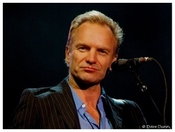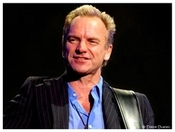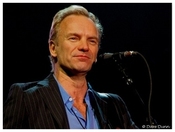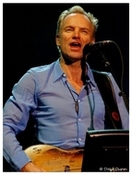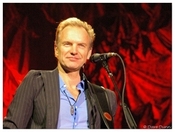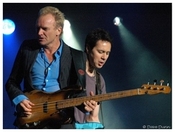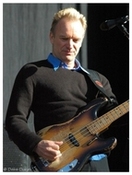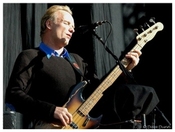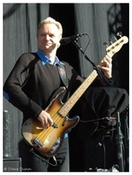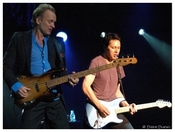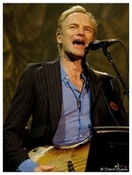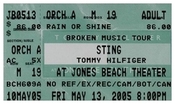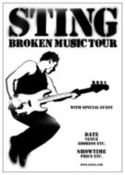
Broken Music
May
13
2005
Wantagh, NY, US
Jones Beach Amphitheaterwith Joss Stone
Sting at Jones Beach...
Rock'n'roll got the sand back between its toes this weekend when the Jones Beach Theater opened for the 2005 summer season with gigs by Velvet Revolver and Sting.
No matter what you've heard about the concert business having one foot on a banana peel and the other in a grave, these two shows - Sting Friday and VR Saturday - showed just how healthy music is. While neither concert was a sell-out, both brought the 15,000-seat amphitheater this close to capacity with very different music and audiences.
For straight ahead, pedal-to-the-metal rock, VR's Beach show was it.
The band, a super group of sorts, features frontman Scott Weiland, the former stoned Temple Pilot, as vocalist backed by the remnants of Guns N' Roses sans Axl. The combination of these two '90s outfits made for a night of very aggressive hard rock that was able to wing from the occasional ballad to headbanging nu-metal with skill.
In a red necktie, a CBGB T-shirt and his prized Hitler hat, the needle-thin Weiland worked the stage like a caged cat. He'd pace in front of the sound monitors with heavy steps, then do a full speed scramble across the stage as if he stepped on a tack. Even though he was in perpetual motion, he never missed a note.
All wrapped in leather Slash, the famed Guns guitarist, now the key force in Velvet's crush of sound, is a sideman - technically. But in concert the fans, who are equally culled from the Stone Temple Pilots' and Guns N' Roses' camps, treated the guitar ace as the group's co-frontman.
The show started slow with a muddied sound mix that nixed any attempt to understand the words Weiland was singing. Wrinkles in the sonics were finally ironed out when VR turned down the volume a click for their huge radio hit 'Fall to Pieces'.
While that one didn't come close to the quality of the studio version, it was enough to get the show sounding better, and with that the performance took off. The all-vice, all-the-time song 'Superhuman' and the band's 'Set Me Free' ranked as the evening's best two originals after they 'Fell to Pieces'. The other terrific outing was when they tackled a cover of Pink Floyd's 'Hey You' from 'The Wall'.
Sting had similar success the previous night at the Beach also, with a cover song. He introduced the Lennon/McCartney classic 'A Day in the Life', telling the house how he was walking through Central Park's Strawberry Fields that morning and how he was thinking of John Lennon and how big a debt his own music owes The Beatles.
While 'A Day in the Life' seems like an unusual choice, the surging, building nature of that piece segued perfectly into Sting's own 'King of Pain'.
Of course, there were a few jazzy snoozers, like his fox-hunt song, that were buoyed with a heap of Police classics, including the reggae-tinged 'Message in a Bottle', 'Driven to Tears', 'Roxanne', and the rare 'Spirits in a Material World'. Yet even the slow ones had the house on its feet bouncing during the two-hour performance.
Between his requests for something hot to drink on a very chilly evening - the coldest Jones Beach opening concert in memory - and his song introductions, Sting projected a relaxed grace as if he was in his living room.
Maybe it's in the ocean air of Jones Beach, but like Sting, even the bad boys of Velvet Revolver seemed to be extremely serene even as their music raged.
(c) New York Post by Dan Aquilante
A Stripped-Down Sting, Tapping His Early Essence...
No keyboards, no horns, no backup singers, no video screens showing rain-forest fantasies. Sting came to Jones Beach Theater here on Friday night with just a four-piece band for the last public show of his Broken Music tour. It was a rejuvenating return to the kind of lean, limber band that Sting hasn't led since the Police, a trio, broke up in 1986.
Elsewhere on the tour, Sting had been performing at midsize halls on college campuses, which was more sensible than prematurely opening an outdoor amphitheater with a chilly ocean breeze. Sting suggested that audience members hug one other to keep warm, and his last encore was 'Lithium Sunset,' with its refrain of 'see mercury falling.' Yet cold fingers didn't slow down the band.
Sting promised to play songs he hadn't performed in ''many, many years'' (not counting previous tour stops). That meant going back to his songs for the Police and the way they turned rock inside out. With Sting on bass as the band's main songwriter, and with ears tuned as much to reggae and jazz as to punk rock, the Police often used the guitar for translucent washes of harmony and texture while bass and drums moved into the foreground.
At Jones Beach, Sting revived Police songs like 'Demolition Man' and 'Spirits in the Material World' in which bass lines are the true hooks. His band unabashedly reclaimed the Police sound, from the crisp snare-drum snickers and cymbal flurries of Josh Freese (from A Perfect Circle) on drums to the watery effects of Dominic Miller and Shane Fontayne on guitars.
They batted around syncopations and floated guitar tones in midair. They also fell into place as a backup band for songs from Sting's own albums that hinted at stately British ballads, like 'Fields of Gold,' 'If I Ever Lose My Faith in You,' and 'Why Should I Cry for You?', and explored vamps in 'No Rain', 'I Hung My Head' and 'End of the Game'. To pay tribute to the Beatles, Sting chose one of their most elaborately orchestrated songs, 'A Day in the Life,' and proved he could do it justice with just two guitars, bass and drums.
Sting didn't choose his most cheerful songs. Even as the Police were revitalizing rock rhythm, Sting had somber thoughts, despairing about the human condition and his own sanity in songs like 'Invisible Sun' and 'King of Pain'. But the music always refused to weigh them down further. A song like 'Driven to Tears' - about famine, atrocities and powerlessness - was also about the exhilaration of shifting rhythms, a sly reggae undercurrent and Sting wailing, 'Whoa!' Two decades later, the messages still came through the songs, but so did the musicianly joy.
Through his solo career, determined to keep trying new things, Sting has piled on instruments and exotica, literary flourishes and sometimes strained concepts. Peeling them away for this tour is partly a retreat, an admission that some of his best music was made two decades ago in a fractious band, before he was fully in charge. But it could also be a turning point: a rediscovery of the old artistic axiom that less can be more.
(c) The New York Times by Jon Pareles
Rock'n'roll got the sand back between its toes this weekend when the Jones Beach Theater opened for the 2005 summer season with gigs by Velvet Revolver and Sting.
No matter what you've heard about the concert business having one foot on a banana peel and the other in a grave, these two shows - Sting Friday and VR Saturday - showed just how healthy music is. While neither concert was a sell-out, both brought the 15,000-seat amphitheater this close to capacity with very different music and audiences.
For straight ahead, pedal-to-the-metal rock, VR's Beach show was it.
The band, a super group of sorts, features frontman Scott Weiland, the former stoned Temple Pilot, as vocalist backed by the remnants of Guns N' Roses sans Axl. The combination of these two '90s outfits made for a night of very aggressive hard rock that was able to wing from the occasional ballad to headbanging nu-metal with skill.
In a red necktie, a CBGB T-shirt and his prized Hitler hat, the needle-thin Weiland worked the stage like a caged cat. He'd pace in front of the sound monitors with heavy steps, then do a full speed scramble across the stage as if he stepped on a tack. Even though he was in perpetual motion, he never missed a note.
All wrapped in leather Slash, the famed Guns guitarist, now the key force in Velvet's crush of sound, is a sideman - technically. But in concert the fans, who are equally culled from the Stone Temple Pilots' and Guns N' Roses' camps, treated the guitar ace as the group's co-frontman.
The show started slow with a muddied sound mix that nixed any attempt to understand the words Weiland was singing. Wrinkles in the sonics were finally ironed out when VR turned down the volume a click for their huge radio hit 'Fall to Pieces'.
While that one didn't come close to the quality of the studio version, it was enough to get the show sounding better, and with that the performance took off. The all-vice, all-the-time song 'Superhuman' and the band's 'Set Me Free' ranked as the evening's best two originals after they 'Fell to Pieces'. The other terrific outing was when they tackled a cover of Pink Floyd's 'Hey You' from 'The Wall'.
Sting had similar success the previous night at the Beach also, with a cover song. He introduced the Lennon/McCartney classic 'A Day in the Life', telling the house how he was walking through Central Park's Strawberry Fields that morning and how he was thinking of John Lennon and how big a debt his own music owes The Beatles.
While 'A Day in the Life' seems like an unusual choice, the surging, building nature of that piece segued perfectly into Sting's own 'King of Pain'.
Of course, there were a few jazzy snoozers, like his fox-hunt song, that were buoyed with a heap of Police classics, including the reggae-tinged 'Message in a Bottle', 'Driven to Tears', 'Roxanne', and the rare 'Spirits in a Material World'. Yet even the slow ones had the house on its feet bouncing during the two-hour performance.
Between his requests for something hot to drink on a very chilly evening - the coldest Jones Beach opening concert in memory - and his song introductions, Sting projected a relaxed grace as if he was in his living room.
Maybe it's in the ocean air of Jones Beach, but like Sting, even the bad boys of Velvet Revolver seemed to be extremely serene even as their music raged.
(c) New York Post by Dan Aquilante
A Stripped-Down Sting, Tapping His Early Essence...
No keyboards, no horns, no backup singers, no video screens showing rain-forest fantasies. Sting came to Jones Beach Theater here on Friday night with just a four-piece band for the last public show of his Broken Music tour. It was a rejuvenating return to the kind of lean, limber band that Sting hasn't led since the Police, a trio, broke up in 1986.
Elsewhere on the tour, Sting had been performing at midsize halls on college campuses, which was more sensible than prematurely opening an outdoor amphitheater with a chilly ocean breeze. Sting suggested that audience members hug one other to keep warm, and his last encore was 'Lithium Sunset,' with its refrain of 'see mercury falling.' Yet cold fingers didn't slow down the band.
Sting promised to play songs he hadn't performed in ''many, many years'' (not counting previous tour stops). That meant going back to his songs for the Police and the way they turned rock inside out. With Sting on bass as the band's main songwriter, and with ears tuned as much to reggae and jazz as to punk rock, the Police often used the guitar for translucent washes of harmony and texture while bass and drums moved into the foreground.
At Jones Beach, Sting revived Police songs like 'Demolition Man' and 'Spirits in the Material World' in which bass lines are the true hooks. His band unabashedly reclaimed the Police sound, from the crisp snare-drum snickers and cymbal flurries of Josh Freese (from A Perfect Circle) on drums to the watery effects of Dominic Miller and Shane Fontayne on guitars.
They batted around syncopations and floated guitar tones in midair. They also fell into place as a backup band for songs from Sting's own albums that hinted at stately British ballads, like 'Fields of Gold,' 'If I Ever Lose My Faith in You,' and 'Why Should I Cry for You?', and explored vamps in 'No Rain', 'I Hung My Head' and 'End of the Game'. To pay tribute to the Beatles, Sting chose one of their most elaborately orchestrated songs, 'A Day in the Life,' and proved he could do it justice with just two guitars, bass and drums.
Sting didn't choose his most cheerful songs. Even as the Police were revitalizing rock rhythm, Sting had somber thoughts, despairing about the human condition and his own sanity in songs like 'Invisible Sun' and 'King of Pain'. But the music always refused to weigh them down further. A song like 'Driven to Tears' - about famine, atrocities and powerlessness - was also about the exhilaration of shifting rhythms, a sly reggae undercurrent and Sting wailing, 'Whoa!' Two decades later, the messages still came through the songs, but so did the musicianly joy.
Through his solo career, determined to keep trying new things, Sting has piled on instruments and exotica, literary flourishes and sometimes strained concepts. Peeling them away for this tour is partly a retreat, an admission that some of his best music was made two decades ago in a fractious band, before he was fully in charge. But it could also be a turning point: a rediscovery of the old artistic axiom that less can be more.
(c) The New York Times by Jon Pareles

